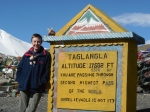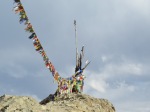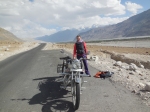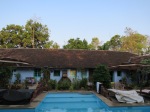A two-day trip, this time from the comfort of the back of a car. Plan A, leave Leh early (5.30am) so that we could enjoy the three 4,800m plus passes in daylight, and have time to relax in Jispa in the evening.
Everything started very well. We crossed the TaglungLa – the world’s second highest road – and dropped down to the Morey Plains. Enjoyed seeing yak, horses and goats grazing on what we thought was the valley floor. Bit of a surprise when the road bent right at the end and a chasm opened up on the left. Best not to look.
Crossed the LashulungLa without trouble and stopped in Sarchu for lunch. 

About 3pm we were at the top of the BaralachLa and enjoying snow all around, more on this pass than on any other, which was odd as this is the lowest of the three. When we got stuck in a traffic jam. A combination of snow narrowing the road, and lots of lorries. We were stuck for four hours but did eventually get going again. Only to be stuck again half an hour later.
It quickly became clear we were going to be stuck for the night. Without food, facilities, or really enough warm weather clothes. We did our best, settling down in the car with the driver. I couldn’t sleep – couldn’t lie down because the altitude (4,800m) was affecting my breathing – never mind the cold.
The Indian police arrived at 1am to try to clear the road but to no avail. Not sure I’ve ever been so pleased to see sunrise.
 The next morning it was clear there would not be a quick resolution, so Martin and I walked down 15km to get out of the altitude and get some food. We waited at a seasonal cafe, and waited, and waited. We had just arranged a couple of berths in a tent for the night (with even less clothes as we’d left everything in the car at the top) when the first lorries came down at 4pm.
The next morning it was clear there would not be a quick resolution, so Martin and I walked down 15km to get out of the altitude and get some food. We waited at a seasonal cafe, and waited, and waited. We had just arranged a couple of berths in a tent for the night (with even less clothes as we’d left everything in the car at the top) when the first lorries came down at 4pm.
Our car appeared at 5pm and we set off. Quite comic at the check point in Darcha. Big queues of lorries and cars held back until the pass was clear – everyone stopping us to find out the situation.
Arrived Manali at midnight, tired but pleased.





















